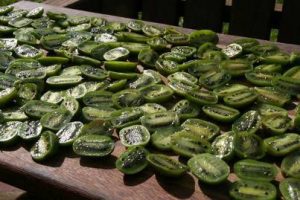Technically, known as ‘cold hardy kiwi’ fruit, these miniature cousins of the familiar fuzzy brown kiwi are known as kiwi berries, kiwi grapes, or baby kiwis. Because super foods and mini fruits and vegetables are all the rage, commercial growers are scrambling to establish large plantings of this old ornamental vine that happens to bear edible, extra healthy fruits.
Since it’s new and cool, this long lost fruit will be pricey until supply exceeds demand (translation: decades). But guess what? It’s actually easy to grow, highly nutritious with antioxidant perks, and delicious with a nicely balanced sweet and tart flavor.
 Before You Buy Plants
Before You Buy Plants
Getting fruit requires at least two vines – a male and a female plant. There is a self-fertile female called ‘Issai’ on the market, but reports say the harvest is poor to pitiful without a male Actinidia nearby.
Many think trendy kiwi berries come only from the Actinidia arguta plant. Actually, there are 3 different Actinidia that bear these edible berries, but only 2 of them taste great. Your climate will direct you to the right species to get for growing your own berries at home.
For no-fail fruiting, Actinidia arguta is best grown in zone 6 or warmer, because though the vine is perennial and will rapidly replace itself each spring in locations with winter temps that drop to -10°F (zone 5). You want Actinidia kolomikta in zones 4-5, which will survive -40°F, but fruiting is unlikely in summers after winter temperatures that low. And though you have smaller harvests and smaller fruits, this one’s berries have more vitamin C with a higher sugar content.
Growing Kiwi Berries
You need a heavy duty, well-anchored trellis. A. arguta grows 20′ a year and can bear 100 pounds of fruit per plant. A. kolomikta has variegated leaves and grows 10′ a year. Proper pruning in winter can increase your harvest, while summer pruning keeps the vine size under control.

Plant all one species spaced 10 feet apart. You want no more than 6 females per male vine to ensure good pollination. Fruiting starts about 3-5 years after planting.
Sun exposure recommendations are confusing. Commercial growers plant cold hardy kiwi like grapes in a vineyard – in full sun in open fields. The University of Minnesota, however, advises placing them on the north side or east side of a building or group of trees where they will have afternoon shade and protection from winter sunshine. In the home garden in zones 4-5, I would follow the university’s direction for best fruit production in a small space.
Kiwi vines need good air circulation and loose, humus-rich, well-drained soil with 5.5-7.5 pH and excellent moisture retention. Make sure the roots don’t dry out – drought-stress causes undersized fruit and berry drop and makes them prone to winter injury. Mulching them with 3-4 inches of wood chips helps maintain consistent moisture.
While not prone to insect damage, you will need to protect your kiwi berries from rabbits from late fall through spring when their food sources are scarce. Some 3-4′ tall woven wire fencing secured to step-posts is a great seasonal protector. They are also pretty disease free unless your soil has poor drainage or you water them too much, which causes root rot issues.
The Harvest
Kiwi berries ripen from July-August through September, which means they don’t all come in at once. That’s awesome, you’ll enjoy weeks of freshly picked, vine-ripened fruits. They do hold up well for up to 2 weeks in refrigeration.
There’s no need to peel a kiwi berry. Eat them whole or sliced into salads much like other fruits, but more creative recipes exist. They’ll certainly add great health benefits however you eat them, as they’re chock full of vitamins, antioxidants, and fiber.
Wondering if you can preserve the harvest by canning? No tested recipes exist yet, according to the Oregon State Extension, but you can freeze them whole and sliced. However, people do preserve regular Kiwis as fruit butter, and the minis are naturally high in pectin. So, you might find that they’re a lot like a strawberry when it comes to preservation. The last two links below show that people are canning kiwi berry fruits, and one winery turns A. kolomikta into one of their top-seller wines.
Learn More/Sources:
- Kiwi Berry Health Benefits
- Cornell University Grow Facts (zone 5)
- University of Minnesota (zone 4)
- Is Kiwi Vine Invasive?
- Some Kiwi Berry Recipes
- Freezing Your Kiwi Berry Harvest
- Hardy Kiwi Wine
- Kiwi Berry Jam
Images courtesy of Brendon Connelly, e-ogrody, and The Fruit Nut (respectively).
 Before You Buy Plants
Before You Buy Plants
Wonderful article, thank you! I have bought Issai and Kens Red with a male pollinator plant. I’m excited to see them grow and hopefully fruit for us.
We appreciate the feedback. thank you